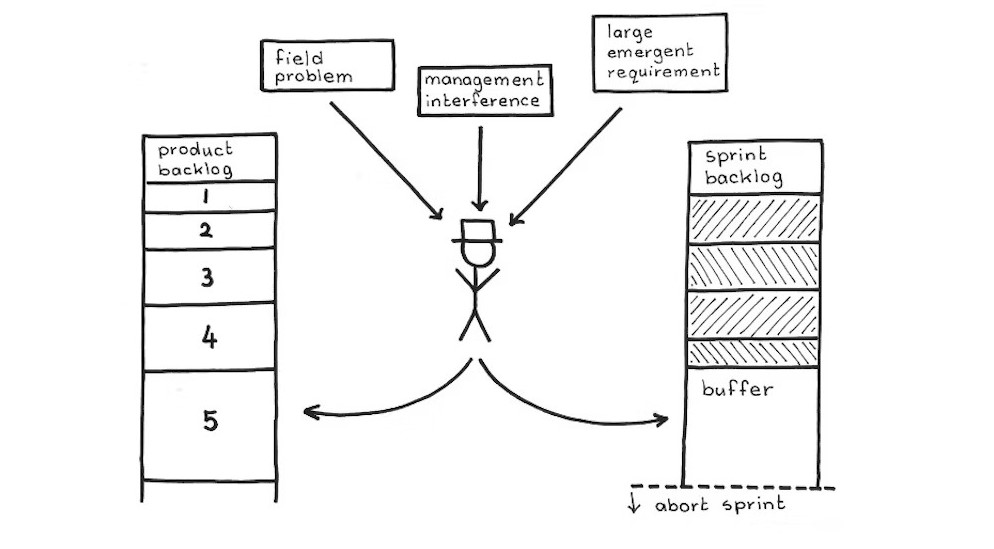In the design and construction industry, teams often struggle with interruptions and distractions that can hinder productivity and progress. When I survey construction professionals about how often and how long they are interrupted, the answers are shockingly common.
- I’m interrupted every day, three to five hours per day.
~Typical Construction Professional Response
The Interrupt Pattern (Buffer Pattern/Illegitimus Non-Interruptus Pattern) provides a solution to this challenge by creating a culture of uninterrupted work time that fosters focus and collaboration. This is a once-a-day time-boxed buffer for interruptions.
Problem: Design and construction teams face numerous interruptions, such as unexpected meetings, phone calls, urgent requests, RFIs, unforeseen conditions, etc., which disrupt their flow and make it difficult to get work done. These interruptions can also cause delays and reduce the team’s overall effectiveness and project delivery speed.
Countermeasure: Implement the Interrupt Pattern by setting aside dedicated work and open work times for team members. During the dedicated work time, team members focus solely on their work without interruption, allowing them to maintain their flow and momentum.
Question: How long should the open time for interruptions be set?
Answer: Determine the daily buffer size by using the rolling average of the length of time you are interrupted daily over the last three Sprints (if you Sprint weekly using Scrum) or the last three weeks. In Scrum, we call this rolling average “Yesterday’s Weather.”
- A project engineer said she was interrupted and taken away from assigned work for about 3 hours per day most days of the week. She should plan for a 3-hour interrupt buffer time. This means each day she should allocate 3 hours to unassigned work. If she works 10 hours per day, she is planning on 70% of her time as dedicated work and 30% of her time as open work time.
- Superintendents often say they experience frequent unplanned interruptions from all stakeholders that disrupt their workflow and make it challenging to meet project deadlines and look ahead in the schedule most of the day. If the superintendent works 10 hours per day, they may want to plan for a 6-hour buffer time, dedicating 4 hours to completing assigned tasks allows for addressing interruptions until processes like Scrum, Takt, or Last Planner System® can be implemented to stabilize the workflows.
- Interior designers encounter frequent interruptions that disrupt their design process and hinder their ability to meet project milestone deadlines. If the designer works 8 hours per day, they may want to plan for a 3-hour buffer time to handle unplanned meeting requests. Dedicating 5 hours to focused design work and 3 hours to addressing unforeseen interruptions enables better flow and minimizes the negative effects of interruptions on creative work.
Key Considerations:
- Schedule designated work times on your calendar. These are specific times for you to work uninterrupted. For example, set aside the first two hours of each day for uninterrupted work time. Allow for your buffer time, and then the rest of the day is back for dedicated work time.
- Communicate boundaries. People don’t read minds well so be sure to share this approach with stakeholders, such as clients, designers, trade contractors, and project managers, to minimize interruptions during non-buffer times.
- Create a signal for interruptions, such as headphones on, a red flag, or similar that indicates when someone is in the middle of an uninterrupted work session.
- Empower team members to hold each other accountable for respecting the uninterrupted work time. For example, if someone interrupts a team member during their designated work time, share the process respectfully and let them know you will follow back up with them soon.
Built-in Benefits: The Interrupt Pattern provides several benefits to design and construction teams, including:
- Improved FLOW: With dedicated, uninterrupted work time, team members can maintain their focus and concentration, stay in flow longer, and enjoy increased productivity and output.
- Enhanced collaboration: Uninterrupted work time promotes more effortless collaboration and communication among team members and sufficient time without distractions.
- Reduced stress: Interruptions often cause stress, but using the Buffer Pattern can reduce these negative effects by providing a sense of control and structure to the team’s workday.
The Interrupt Pattern can help design and construction teams overcome interruptions and flow blockers to foster a culture of deeper focus, collaboration, and higher performance. By implementing the pattern based on your team’s exact circumstances, easier, better, and faster project delivery will become typical results for our construction industry.
Inspiration for this pattern, references, image, and more can be found at Illegitimus Non Interruptus.










